- Stat Significant
- Posts
- The Rise of Nicole Kidman, Pop Culture Folk Hero: A Statistical Analysis
The Rise of Nicole Kidman, Pop Culture Folk Hero: A Statistical Analysis
Charting Nicole Kidman's recent career renaissance and rejection of industry norms.

A Family Affair (2024). Credit: Netflix.
Intro: Nicole Kidman is Everywhere
Nicole Kidman has become inescapable over the last five years. She's starring in A24 films, she's leading schlocky Netflix movies, she's appearing in countless streaming series, and she is the face of a bizarre advertisement shown before 20% of U.S. movie screenings.
Kidman's efforts have not gone unnoticed, as her prolific Nicolas Cage-like output has attracted significant media attention. Some of this commentary has been scathing:
Indiewire recently quipped, "We've seen Kidman wafting about as a sad, privileged woman far, far too many times," in an article entitled "Is Nicole Kidman Making Too Much TV?"
Slate has begun referring to Nicole Kidman's work as "Nicole Kidman's Beach-Read Cinematic Universe."
Some, however, see a greater purpose to Kidman's prolific output.
The New York Times published an opinion essay claiming, "Nicole Kidman Knows Exactly What She's Doing."
Elle Magazine crafted a thorough thinkpiece on the "Secret Superpowers of Nicole Kidman."
Ultimately, Kidman is a prime example of a pre-streaming prestige actor successfully adapting to an evolving entertainment landscape.
So today, we'll explore Nicole Kidman's burgeoning career renaissance, her newfound status as a pop culture folk hero, and the unfortunate double standard that dominates media coverage of her career decisions.
The Nicole Kidman Renaissance
For the first 25 years of her career, Nicole Kidman drifted seamlessly between arthouse flicks and mainstream movies. She starred in big-budget blockbusters like Batman Forever and Days of Thunder, as well as Oscar-fodder like Moulin Rouge and Eyes Wide Shut. She was a staple of tabloid culture due to her marriage with Tom Cruise, and she won an Oscar for her work in The Hours.
Kidman's classical movie stardom made her embrace of streaming all the more surprising. In 2017, she headlined HBO's "Big Little Lies," an early streaming darling that showcased the best that "peak TV" had to offer: high-end production value, big-name stars, gripping story development, and shorter season lengths.
Most high-profile movie actors have limited their television involvement to one or two series for fear of losing their place within the film industry. Kidman, on the other hand, has maintained a foothold in TV and film, frequently starring in multiple theatrical releases and streamer series in a given year.
Over time, her project output has continuously accelerated:
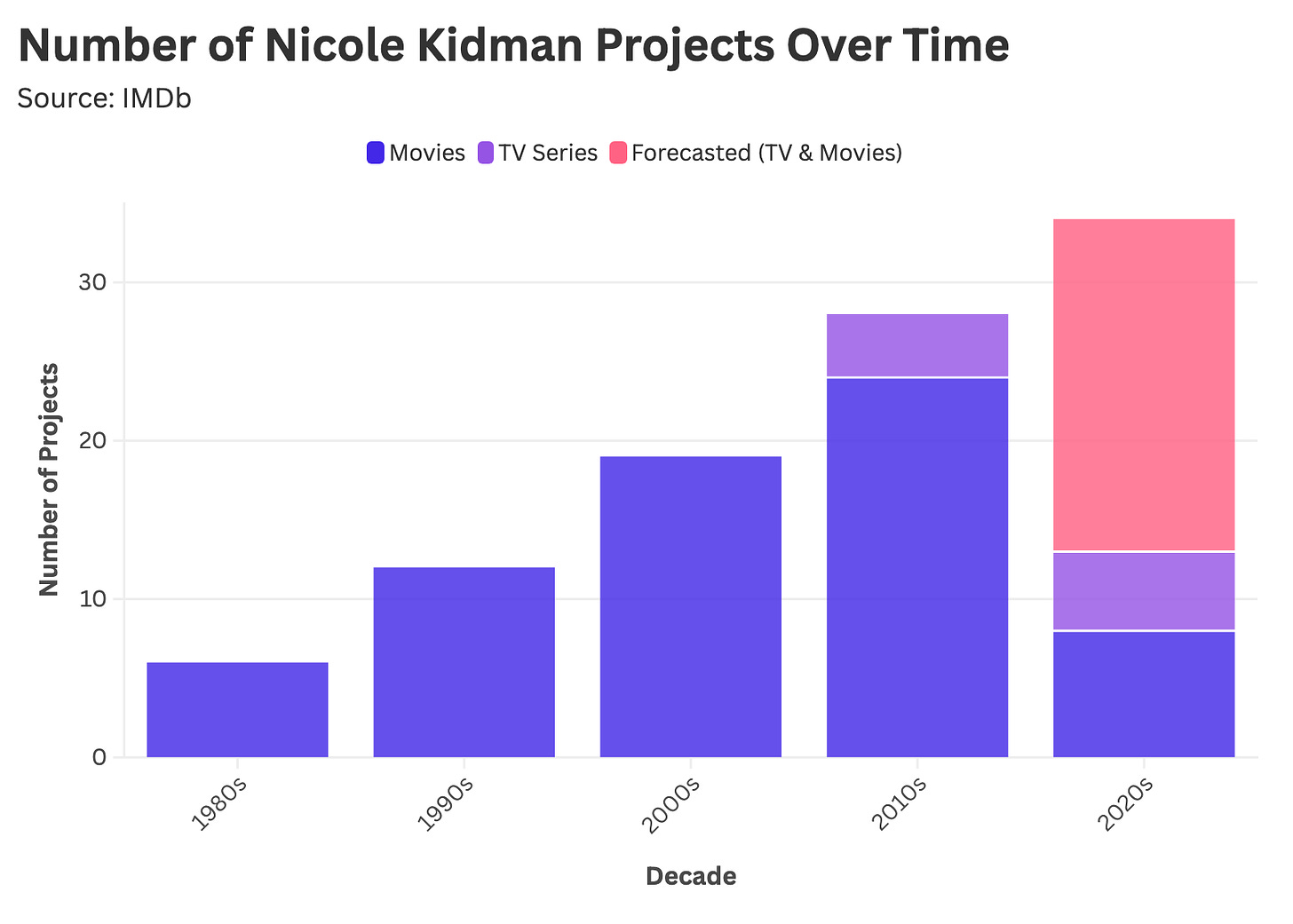
This past year, Kidman starred in an eclectic hodge-podge of projects, including:
"The Perfect Couple": This Netflix murder mystery was not meant to be taken seriously; every episode opens with a choreographed dance number performed by the entire cast.
Babygirl: An erotic thriller from A24 about a high-powered CEO having an affair with a younger intern. Kidman won Best Actress at the Venice Film Festival and will likely get an Oscar nomination for her work in this movie.
"Lioness": From "Yellowstone" creator Taylor Sheridan, this streaming series follows a CIA operative engaged in a fight against terrorism. Kidman plays a supporting role along with Morgan Freeman.
"Expats": An Amazon streaming series; I do not know anyone who watched this show.
A Family Affair: A straight-to-streaming Netflix movie where Nicole Kidman has a romantic fling with a younger man. This time, that younger man is Zac Efron.
While undoubtedly generating buzz, Kidman's increased exposure has come at a cost. The quality of her work has begun to dip, with recent TV series struggling to recapture the magic of "Big Little Lies," and her films falling short of the standard she set in the 1990s and 2000s.
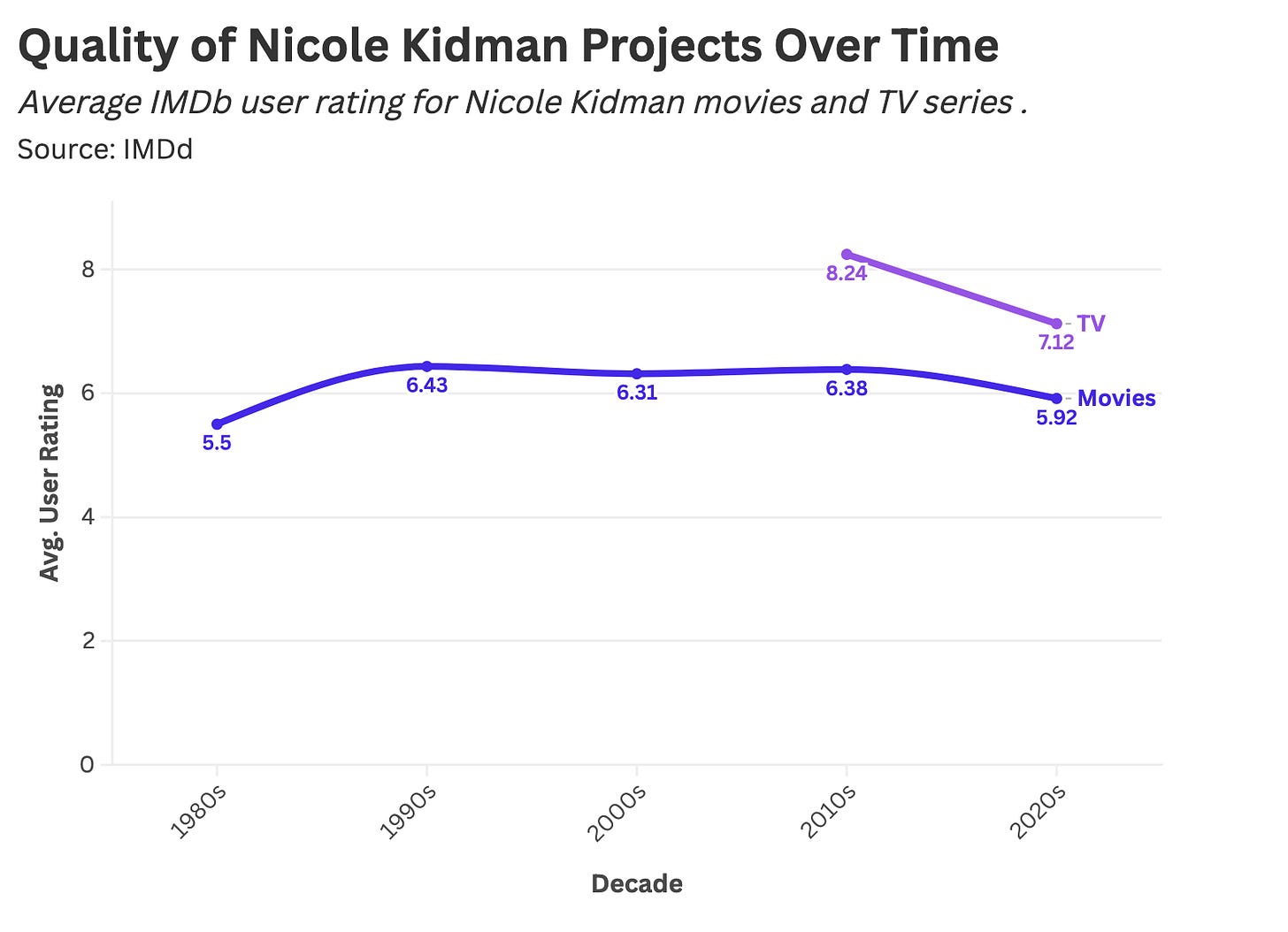
But is this actually a bad thing?
In an attention economy where visibility is relevance, actors often face a trade-off between quality and quantity: is it better to be in the public eye, perhaps for lower-quality work, or to maintain rigorous quality standards while limiting one's exposure?
Said differently, is it better to:
Take on an ambitious film that tries to recapture the magic of a 1990s blockbuster like Forrest Gump, even if it flops in theaters (i.e., Tom Hanks' Here)?
Star in a lowbrow streaming series that everyone will watch?
Kidman's career decisions have erred toward maximal exposure in recent years, a feat solidified by her participation in a long-running AMC advertisement.
Since September 2021, American cineplex chain AMC Theaters has been airing a one-minute advertisement where Nicole Kidman waxes poetic about the magic of movie theaters. This promotion typically aires after twenty minutes of previews and is the last obstacle separating you from the film you came to see. Quite surprisingly, against all odds, audiences love the promotion.
I've always found this ad fascinating because it promotes moviegoing to people who are currently sitting in a movie theater.
That said, through heavy exposure, people have begun associating the promotion with a film's commencement, like the national anthem at a sports game, the Netflix "swoosh" logo animation, or a Better Help advertisement preceding a podcast. Over time, the advert has spawned cultish fandom, including a well-documented instance where a man stood and saluted the ad for the entirety of its one-minute runtime:
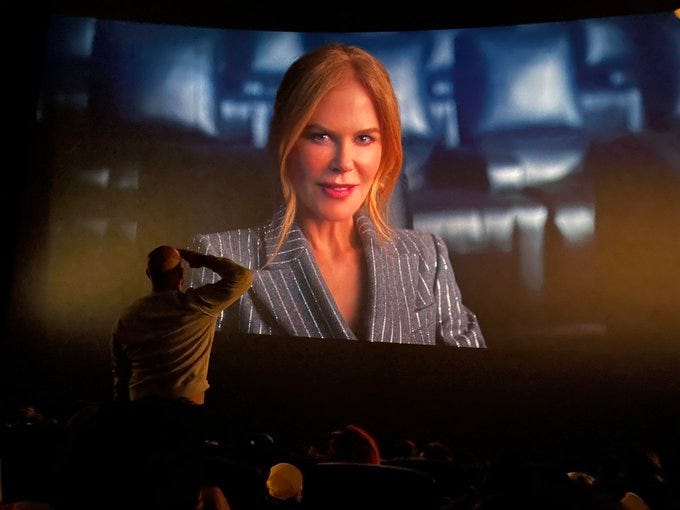
Credit: @davidmackau
The promo's bizarre Stockhold syndrome-like appeal has kept it in circulation for nearly three and a half years.
What does this equate to in terms of exposure? Assuming the advertisement has run before every AMC screening since its release, we can backsolve the promo's reach by working off company earnings data. Using a combination of financial data and sales projections, we calculate that the Kidman ad has received over 715 million impressions (forecasted through the end of 2024).

Put differently, audiences have spent 443,309 days being told how great the movies are while sitting inside a movie theater.
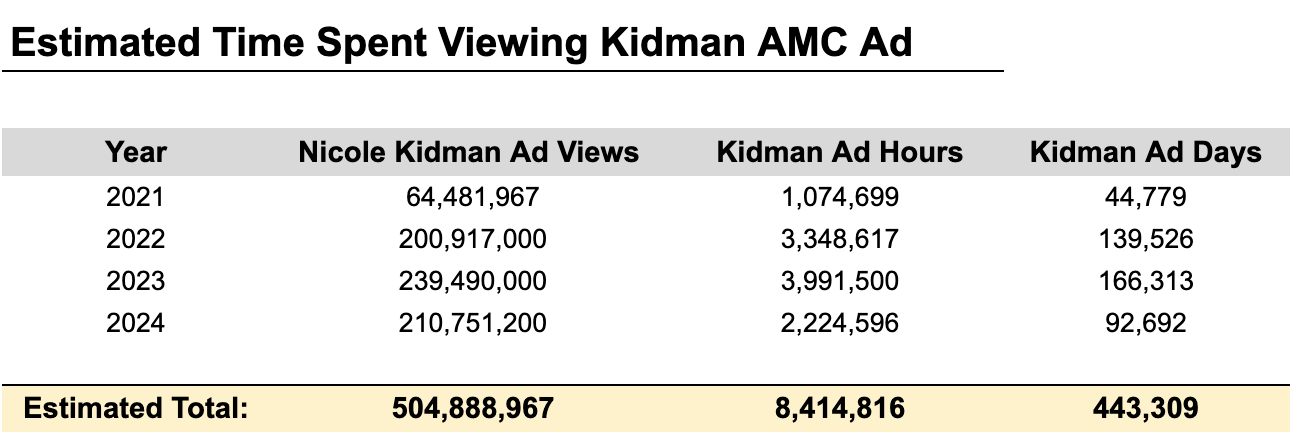
Recently, AMC trimmed the ad down to 30 seconds cutting the promo's beloved "heartbreak feels good in a place like this" line, which has led to widespread boos in several screenings I've attended. Kidman has massively benefited from the mind-boggling exposure of this advertisement, becoming a mascot for moviegoing—even though she subsequently went on to star in several straight-to-streaming projects.
Nicole Kidman's newfound ubiquity has led to rising search interest over the past year, as people have grown increasingly fascinated by Nicole Kidman, pop culture curio.
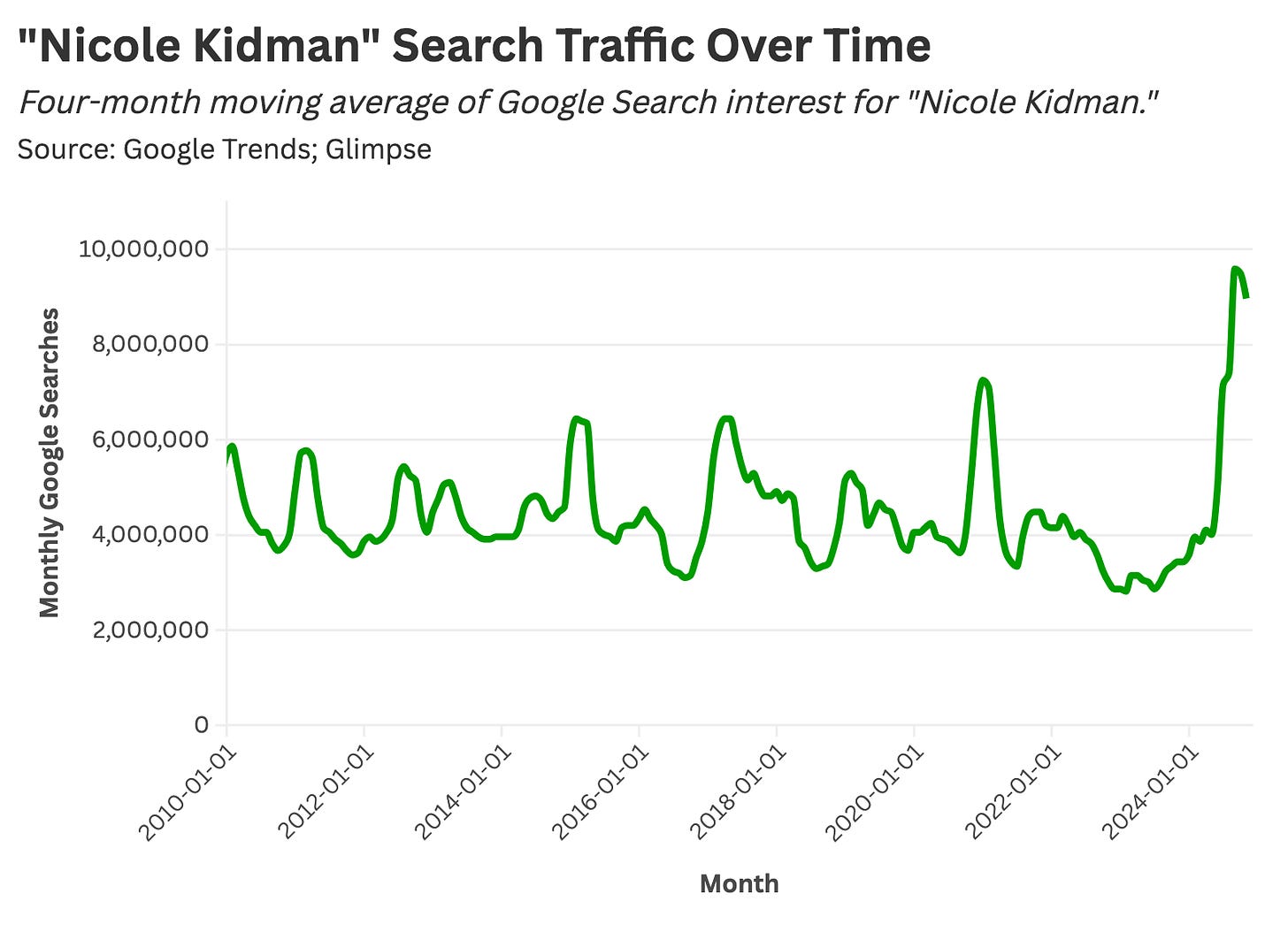
However, visibility comes with an unfortunate consequence. The uniqueness of Kidman's renaissance has been met with undue scrutiny—the darker side of notoriety.
The Unfair Criticism Surrounding Nicole Kidman's Renaissance
Nicole Kidman's recent career decisions serve as a rebuke to Hollywood's long-standing treatment of aging female actors. I've written about this phenomenon many times, but here's the tl;dr: as actresses age, there are fewer available roles—especially leading roles (though representation has gradually improved over time).
Kidman's cultural longevity defies historical precedent, which begets media coverage and criticism—as if she should have disappeared upon reaching a certain age. Unfortunately, this growing preoccupation with Kidman's age can be quantified.
Using a tool called Glimpse, we can track the top queries associated with the Google topic "Nicole Kidman." For most actors, top-ranking search results typically center on their filmography, like "Tom Hanks Movies" or "Meryl Streep Movies and TV." For Nicole Kidman, the top query concerns her age.
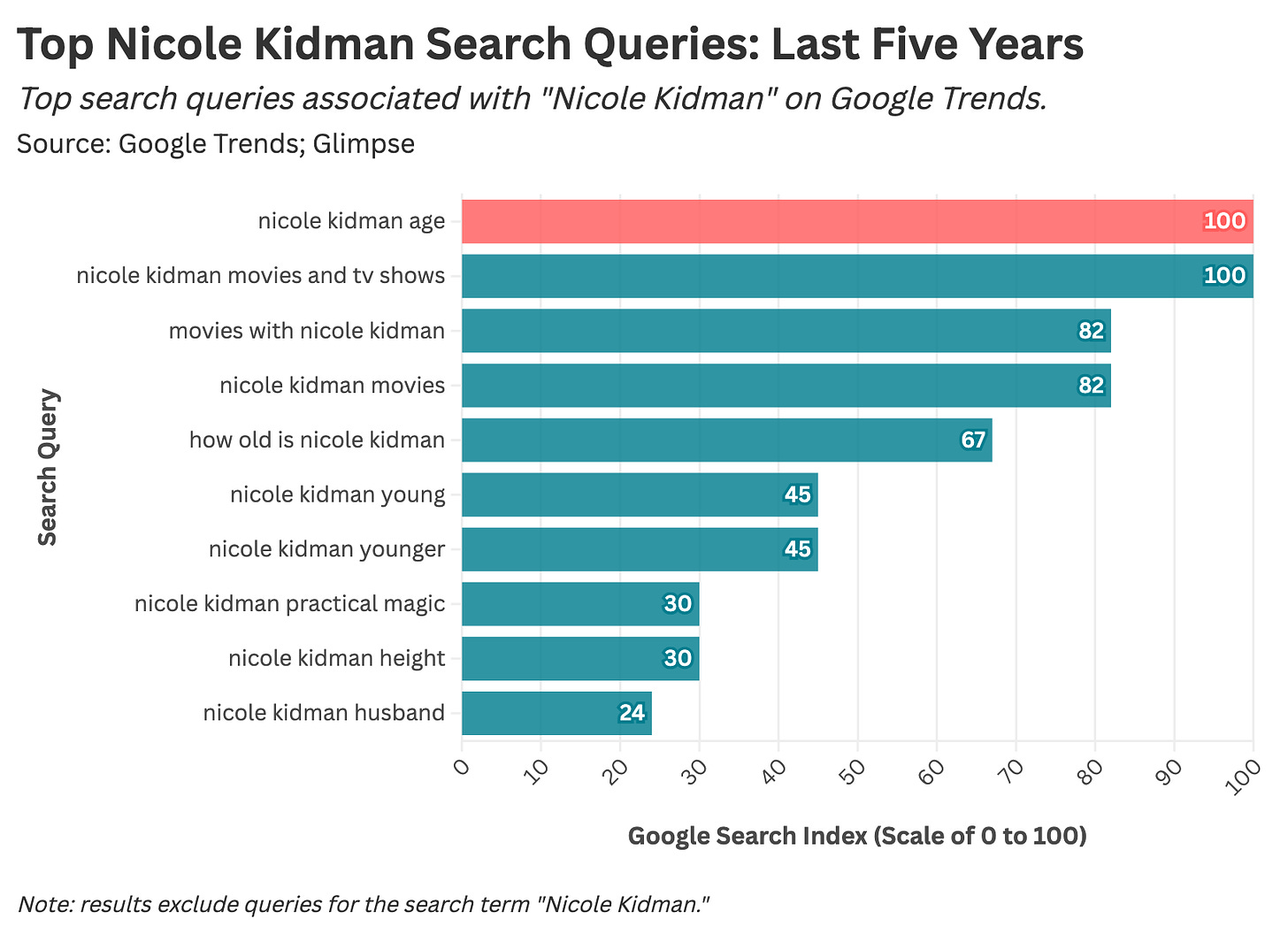
Now compare these results to those of Tom Cruise, Kidman's ex-husband, who is headlining Mission Impossible movies at age 62.
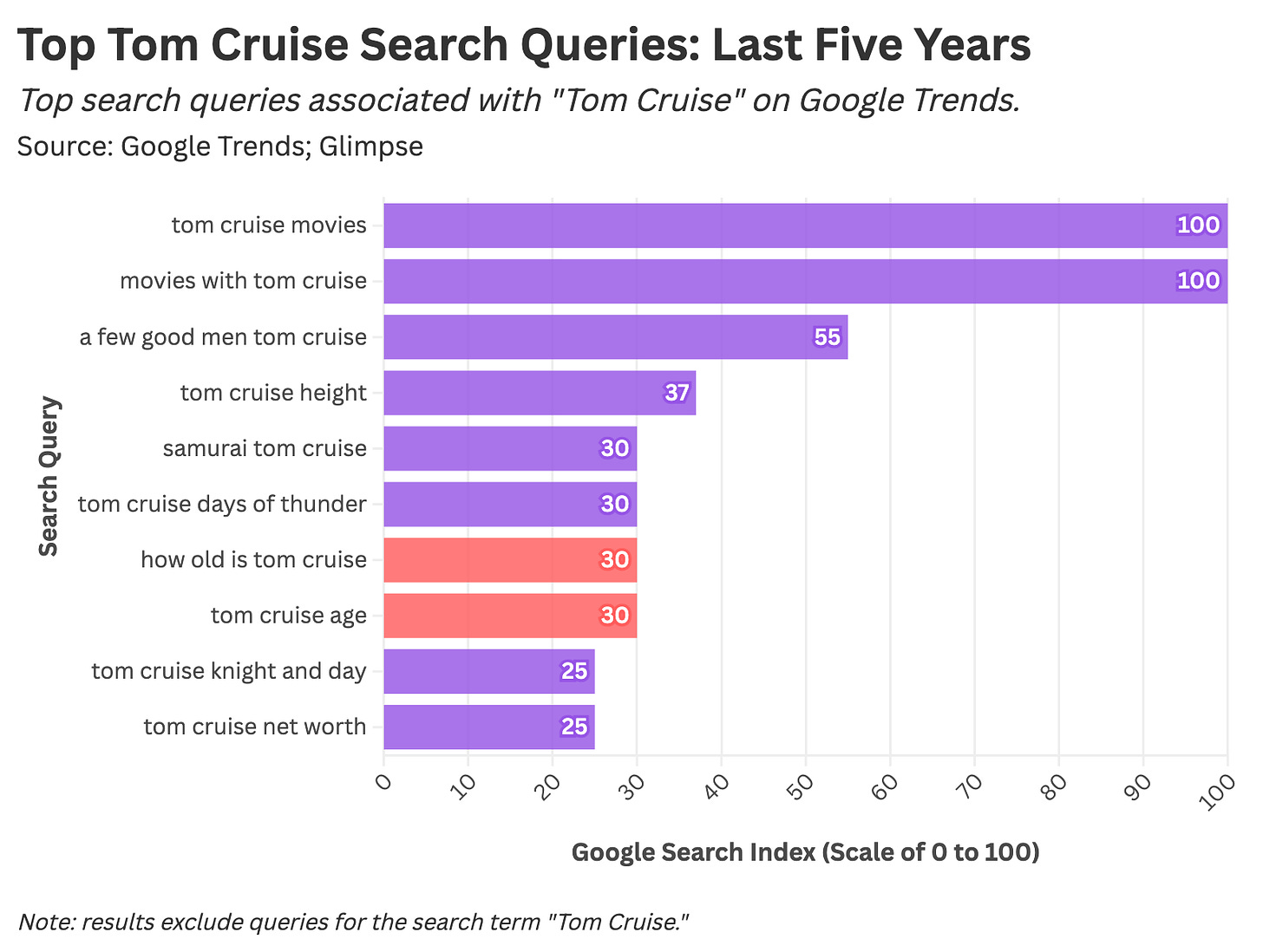
I found similar results when reproducing this analysis for other aging actors, including Tom Hanks, Robert De Niro, Liam Neeson, Al Pacino, etc. For older male performers, online interest centers on their work; for Nicole Kidman, curiosity surrounding her age equals or exceeds that of her acting output.
Some of this discourse supports Kidman's unconventional decisions—in the form of New Yorker-esque think pieces—though a sizable share of coverage scrutinizes her cultural insistence. These critiques frame Kidman as "trying too hard," her recent output an affront to her early work, particularly her embrace of populist projects designed for Netflix consumption.
There is also an unfortunate corner of the internet that is preoccupied with Kidman's appearance, speculating on potential cosmetic enhancements. I'm not going to go super deep on this coverage, but you can bring yourself up to speed pretty quickly if you just Google it.
All this fanfare—good and bad—speaks to the uniqueness of Kidman's late-career renaissance. Perhaps twenty years from now, something like this will be a non-story; nobody will think twice about a middle-aged actress starring in straight-to-streaming content opposite a younger love interest. Or maybe Nicole Kidman is a one-of-one, caught between pre-streaming fame, an unfortunate double standard, and Netflix's en-shit-ification of content.
Final Thoughts: Is Nicole Kidman the New Nicolas Cage?
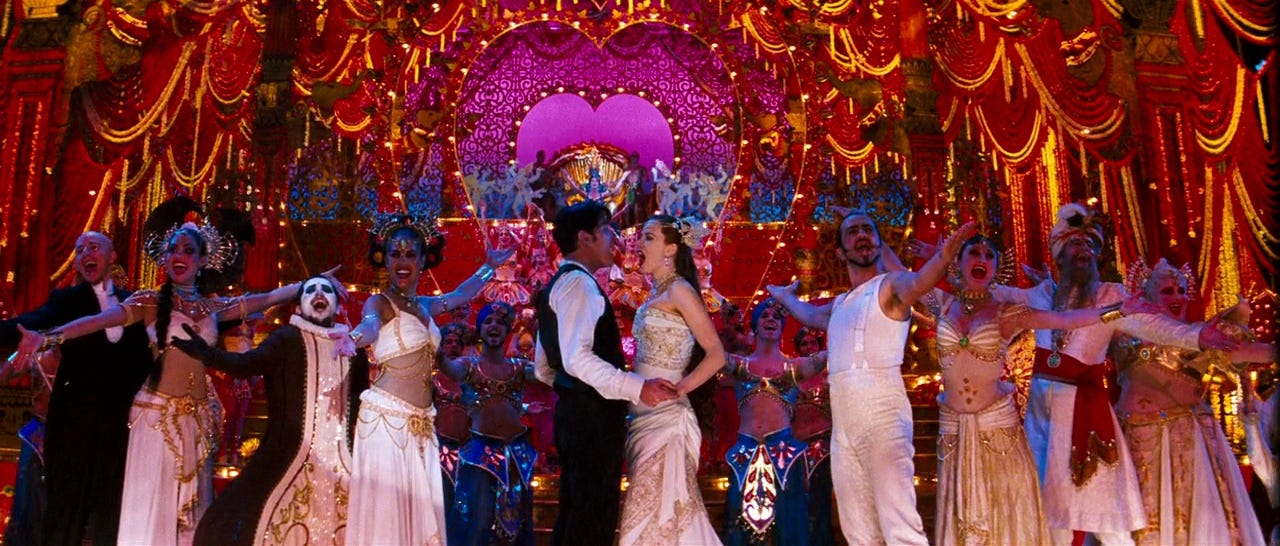
Moulin Rouge (2001). Credit: 20th Century Studios.
Nicole Kidman's late-career renaissance is built upon a rejection of two long-running industry norms:
Movie stars should not sully their brand with television.
An aging actress should accept lesser roles and/or slowly fade from the zeitgeist.
Mix Kidman's defiance with an absurd ad seen over 700M times, and you get a meme—an object of digital culture that symbolizes something greater.
My working title for this piece was "Nicole Kidman is the new Nicolas Cage," and I stand by this half-baked comparison. Both performers are prolific and iconoclastic (for someone of their fame) and have been embraced by digital culture due to their uniqueness. By happenstance or prescience, both actors have adapted to our present-day attention economy, and, subsequently, they've been rewarded with sustained attention—the highest honor one can receive in an age of TikTok and "Love is Blind: Brazil."
Consider some of Nicole Kidman's contemporaries:
Tom Hanks: Tom Hanks' much-maligned Here grossed a paltry $4.9M its opening weekend on a budget of $50M. I know this is the second time I'm referencing this movie, but it's a perfect encapsulation of aging Hollywood creators failing to understand contemporary cultural appetites. Apologies to all who enjoyed Here (know that you are unique).
George Clooney and Brad Pitt: the recent Clooney-Pitt vehicle Wolfs abandoned plans for a theatrical release, sending the film straight to streaming, where it was little seen. This movie stars TWO actors from Ocean's Eleven—how could people not want to see it?
Matt Damon and Casey Affleck: The Instigators, a movie co-starring Matt Damon and Casey Affleck, was also sent straight to streaming, ditching plans for a wide theatrical release. This movie ALSO stars TWO actors from Ocean's Eleven—how could people not want to see it?
These projects attempted to run back a movie star playbook (circa 1999) that is slowly dying. The entire world watches Netflix, so Nicole Kidman is on Netflix. Those who go to the movies often do so for A24 films, so Nicole Kidman is in an A24 movie. This is not rocket science. Weirder still, Kidman's emergent notoriety is greeted as if a carnivalesque oddity, with pundits fixating on the otherness of her choices.
My best guess is that this media scrutiny will not age well. Nicole Kidman is not some bizarro outlier—she's likely ahead of her time, and we're all struggling to make sense of it.
Struggling With a Data Problem? Stat Significant Can Help!

Having trouble extracting insights from your data? Need assistance on a data or research project? Looking to produce data-centric editorial content? Well, you’re in luck because Stat Significant offers data consulting and data journalism services!
Want to chat? Drop me an email at [email protected], connect with me on LinkedIn, reply to this email, or book a free data consultation at the link below.
Want to chat about data and statistics? Have an interesting data project? Looking to produce data-centric editorial content? Email [email protected]